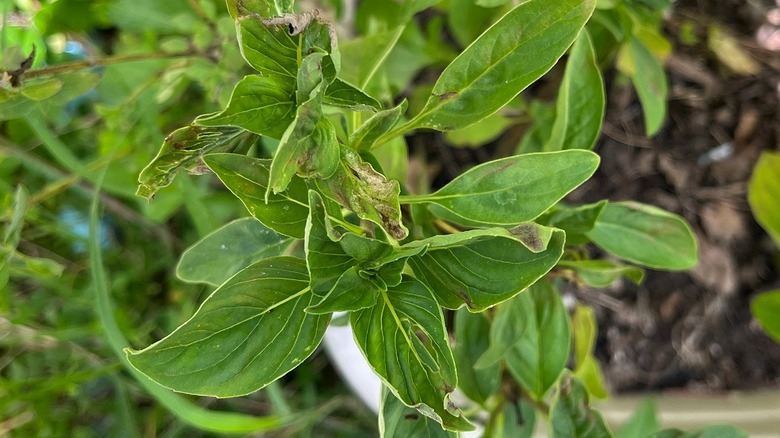How To Stop Your Basil Leaves From Wilting
Aromatic basil (Ocimum basilicum), an annual herb belonging to the mint family, is a popular herb among home gardeners and a relatively easy one to grow. In fact, basil commonly holds a spot on "easiest herbs to grow" lists for beginner gardeners, so when and if you do see your basil plant's leaves wilting, it's certainly cause for concern. Because, despite not being difficult to grow, the herb will begin to droop or wilt if not adequately cared for. Fortunately, the most common cause for wilting basil leaves (dry soil) is also a rather simple gardening problem to address.
Basil is a resilient herb, but it requires proper soil and water management to thrive. A healthy basil plant can grow up to 2 feet or so high, and you can start to harvest its leaves once the plant reaches 6 to 8 inches tall. Early and frequent harvesting will encourage new growth, and it'll also help you catch the first signs of your basil leaves wilting. When you do, it's important to assess the likely cause of your plant's particular condition so you can take appropriate measures to revive it.
Reasons your basil leaves are wilting
If your basil leaves are curling, turning yellow or brown, or the soil is pulling away from the edges of the pot, the most plausible explanation is that your basil plant is thirsty and needs water. Dry soil is the most common reason for wilting basil leaves. Another reason, however, could be that your plant's roots aren't getting enough oxygen, perhaps due to overwatering or poor pot drainage. Either growing condition will make it difficult for the plant to draw oxygen and could even lead to fungal infections, further hampering your plant's growth and health.
This said, if you've ruled out under and overwatering, check if the wilting basil leaves have a gray or purple growth underneath. If that's the case, your plant might be suffering from downy mildew. Similarly, brown stripes on the plant's stem, tissue discoloration, shepherd's crook, or sudden loss of leaves could mean your plant is suffering from Fusarium wilt. Black or brown spots on leaves, a common symptom of cold damage, are another reason for a wilted appearance.
Moreover, if the basil plant isn't receiving six to eight hours of sunlight or is subject to direct sunlight for longer hours, it could cause the leaves to droop. Other reasons include incorrect transplanting, being attacked by aphids and/or spiders, and abrupt weather changes.
Ways to prevent your basil leaves from wilting
Now that you're familiar with the possible reasons why your basil plant's leaves are wilting, it's time to take corrective (and once corrected, preventative) steps. The first step is to dip your finger in the soil and check if the top inch of the soil is dry. If so, water your plant immediately, avoiding its leaves, until the water begins draining out of the pot. However, if the soil is moist, hold off on your watering. You want your plant's soil to be consistently damp or moist — but not wet.
To maintain this middle ground and hopefully keep your basil plant's leaves from wilting more, remain observant until you establish an effective watering schedule for your plant's particular conditions. Note, you might have to water the plant daily during summer, but only around twice a week during winter. During summer, you can also add mulch around the plant's base to help it retain moisture.
Further, if the pot is too small, lacks adequate drainage, or is made of metal or plastic, repot your basil plant in a larger ceramic or clay pot, one with enough drainage holes and that's at least 12 inches wide and 4 inches deep. Other solutions for a basil plant with curling or drooping leaves include pruning the plant regularly, removing any brown or wilted foliage, providing the plant with enough sunlight, and monitoring the plant's health to avoid pests and diseases from taking over.


